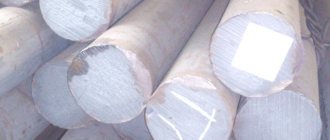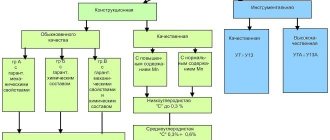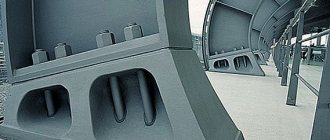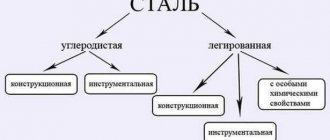What are carbon steels?
Carbon steels are an iron alloy with a carbon content of up to 0.6%. The amount of sulfur and phosphorus depends on the quality of the metal. Alloying elements are present in small quantities. Qualitative characteristics depend on the amount of carbon, sulfur, phosphorus, manganese and silicon.
- hardness;
- weldability;
- strength;
- viscosity;
- elasticity.
The more carbon, the higher the hardness, brittleness and worse weldability.
Use of steel
Carbon steel of various grades is used to make structures in many industries. Depending on the application of the product, certain brands are used.
Regular quality
The amount of foreign impurities in finished products is regulated by GOST 380-2005. Regular quality carbon steel is used to produce:
- St0 – sheathing, fittings, etc.;
- St1 – channels, T-beams and I-beams. It has low hardness but good viscosity;
- St2 – parts of non-critical structures. It is a highly plastic material;
- St3 – rolled metal used for the construction of building structures, bodies, automotive rims, etc.;
- St5 – bolts, nuts, levers, pins, axles, etc.;
- St6 – high-strength parts for woodworking and metalworking machines.
High quality
The following are produced from high-quality steel grades:
Application of carbon steel
- Pipes and parts that are applicable in boiler building.
- Products with high ductility - bolts, nuts, etc.
- Parts intended to create welded structures.
- Various kinds of pipes, pins, axles.
- Gears, clutches of trucks, buses and other equipment.
- Spring washers, rings.
Instrumental
Carbon tool steels of various grades have increased strength and high impact toughness. They are used to create all kinds of tools and replacement elements. During production, products are subjected to repeated exposure to high temperatures, which improves their physical properties. The products are resistant to rapid temperature changes and are highly resistant to corrosion.
General characteristics
Carbon steel is divided into 3 groups according to the requirements for chemical composition and mechanical properties. Letter designation. The defining factors for the group are:
- A - mechanical properties;
- B - chemical composition;
- B - the chemical composition and basic mechanical properties are strictly maintained.
Group B alloys are chemically tested, and a sample is taken from the ladle during a spill to check mechanical properties - tensile and flexural strength, impact strength. Hardness is controlled by heat treatment.
Hardening [edit]
Main article: Surface hardening
Case hardening processes harden only the outside of a steel part, creating a hard, wear-resistant shell ("case") while maintaining a tough, ductile interior. Carbon steels are not very hardenable meaning that they cannot be hardened over thick sections. Alloy steels have better hardenability, so they can be through-hardened and do not require hardening. This property of carbon steel can be beneficial because it gives the surface good wear characteristics but leaves the core flexible and shock absorbent.
Composition of chemical elements
The main element is iron. The relationship to the group is determined by the amount of carbon. The content of non-metallic inclusions of phosphorus and sulfur impairs the mechanical properties. They contribute to red brittleness and cold brittleness, the formation of cracks in hot and cold metal.
Corrosion resistance is ensured by low carbon content and the addition of chromium. The amount of chemical elements in carbon steel, manganese and silicon, depends on the deoxidation method and quality class. Manganese can be present within 1.2% in normal quality alloys, up to 1.8% in high quality alloys. The silicon content does not exceed 0.3%.
High-quality steels of group B are checked for their properties and chemical composition. The permissible amount of non-metallic inclusions is 0.03–0.0018%.
The amount of carbon determines the hardness of steel, its ability to harden and weld.
The lower the carbon index, the better the metal is welded. St 40X requires heating before welding, St 6 requires heating to 700⁰ and post-welding tempering. Hardenability is the opposite. Up to St4 alloys do not heat up and do not change their hardness. 40x steel can crack when exposed to sudden cooling in water.
Heating steel
Structural steels and alloys for low temperatures
4. MEDIUM-ALLOYED STRUCTURAL STEEL
Along with low-alloy steels, medium-alloy chromium-nickel structural steels with additions of tungsten, molybdenum, and vanadium are widely used for non-welded parts at low temperatures. These include steel types 30KhN2MFA, 38KhNZMA, 38KhNZMFA, 18Kh2N4MA (18Kh2N4VA), 12KhNZMA, containing 0.1-0.4% C and from 1.5 to 4% No. To increase toughness at low temperatures, steels are subjected to heat treatment, consisting of quenching and high tempering. The structure of steels after the improvement operation is dispersed sorbitol. Steel 12ХНЗА is used for case-hardened and cyanidated parts, where increased strength and surface hardness in combination with a viscous core are required. Valve bodies, piston expander cylinders, valve and pump parts are also made from it. Steel 18Х2Н4МА is used for the manufacture of critical, highly loaded parts operating under static, cyclic and dynamic loads with an operating temperature of 200–670 K (studs, hangers, axles, turboexpander shafts, etc.). In table Table 13 shows the mechanical properties of steels of this class. An assessment of the static strength of steel 30KhN2MFA, carried out on rod metal with a diameter of 20-60 mm, shows (Table 13) that after quenching from 860 °C in oil and tempering at 680 °C for 1.5 h with air cooling, the steel retains high ductility up to 77 K.
In steel 38KhNZMA, compared to steel 30KhN2MFA, with a higher nickel content, the carbon content is noticeably higher, which leads to a less favorable effect of the notch on ductility. All other things being equal, the temperature level of use of 38KhNZMA steel should be higher than for steels 30KhN2MFA and 18Kh2N4VA. Steel 18Х2Н4ВА has the greatest ductility at low temperatures. It should be noted that low-temperature tempering, while providing a high level of hardness (NSC>40), necessitates the use of tools with increased cutting properties, so in practice this mode is used relatively rarely. Tempering at 560 °C, providing high values of impact strength at temperatures of 293 K, often gives a large spread in impact strength at 77 K. In this regard, tempering at 620-650 °C is preferable in the case of operation of the part at temperatures up to 77 K.
Data on smooth samples, with one annular cut, with threaded threads along the entire length, as well as on stud simulators (Fig. 54) are given in Table. 15 (the denominator shows the results of testing samples with a skew of 5°).
To compare the elongation of threaded samples and studs upon failure, their total elongation D was determined from the test machine diagram, keeping in mind that the total working length of the samples, including the screw-in height, in all cases was equal to 50 mm. The cut and thread profiles were checked before and after testing.
Analysis of the data given in table. 15 shows that 38KhNZMA steel has low ductility when deformed in liquid nitrogen in the presence of a thread (threaded sample and stud). At the same time, the negative impact of the distortion is clearly visible. In the case of transition to the manufacture of a stud sample with a central groove, when the effect of the concentrators is minimized, the metal has satisfactory ductility. In the presence of such a groove, the breaking load decreased by 20% while the relative narrowing increased twofold at 293 K and sixfold at 77 K.
Steel 38KhNZMA in a heat-treated state can be recommended for use at temperatures up to 170 K. Steel 18Kh2N4VA, even with an unfavorable form of fasteners, has satisfactory ductility at 77 K and is little sensitive to misalignment. However, for critical studs, it is advisable to use grooving of the central zone to a diameter that is 0.3-0.5 mm smaller than the internal diameter of the thread. When using a rod for parts with a diameter of more than 60 mm, the minimum temperature for using steel must be increased. An analysis of the behavior of 18Kh2N4VA steel when operated in liquid nitrogen did not reveal a negative effect of long-term loading (in experiments from 250 to 1500 hours) on mechanical properties; the residual deformation did not exceed 0.02%. An assessment of the relaxation resistance of 18Kh2N4VA steel when exposed to liquid nitrogen under stress of 450 and 320 MPa for up to 450 hours showed that in the first hours the stress drops to 420 and 300 MPa, respectively, remaining unchanged throughout the experiment.
5. MARTENSITE-AGING STEEL
A distinctive feature of maraging steels is the production of virtually carbon-free martensite during quenching and its subsequent aging at a temperature of about 500 °C, accompanied by the precipitation of intermetallic phases, which provides a combination of high strength properties with sufficient ductility and toughness. After heat treatment, their temporary resistance at room temperature is no more than 1800 MPa, the yield strength is 1500 MPa with a relative contraction of 40% and the impact strength on samples of the first type is 0.6 MJ/m2. The danger of brittle fractures of maraging steels, unlike other high-strength structural steels, is reduced due to the high nickel content and low carbon (no more than 0.03%). The high content of alloying elements and low carbon concentration prevent the formation of non-martensitic products of austenite transformation, regardless of the cooling rate during quenching. In steel
03N18K9M5T martensitic transformation begins at room temperature. Carbon-free quenched martensite has low strength, but has very high ductility. In the hardened state, steel is well processed by pressure and cutting.
Reducing the test temperature from room temperature to 77 K leads to an increase in the yield strength of 03N18K9M5T steel from 1750 to 2250 MPa with an elongation of 6%; In this case, fracture toughness decreases by more than 2 times [98]. Maintaining the high toughness of steel at low temperatures is achieved due to the presence of sufficient amounts of stable residual austenite in the structure after hardening. The introduction of chromium into maraging steel reduces the susceptibility to general and stress corrosion.
One of the first domestic maraging-aging stainless steels based on Fe-Cr-Ni is steel 08Х15Н5Д2Т (Table 16), developed by Ya. M. Potak and Yu. F. Orzhekhovsky [99]. After hardening, the steel has a martensite structure and about 10% retained austenite. Its temporary resistance after hardening at 870 °C, cold treatment and aging at 450 °C is more than 1300 MPa. Aging of steel in a cold-worked state increases the tensile strength to 1400 MPa. When the aging temperature increases to 600–640 °C, corresponding to the reverse α-γ transformation, stable austenite is formed. Its stabilization is associated with the enrichment of austenite with nickel and, as a result, a decrease in the martensitic transformation temperature. However, aging at 600–640 °C significantly reduces the strength of steel.
Steel 03Х11Н10М2Т after hardening has high strength values (0В more than 1500 MPa) in combination with sufficient ductility. However, with such strength, it is not suitable for use at cryogenic temperatures. In the hardened state, the temporary resistance of steel is about 1000 MPa, but the steel retains high values of ductility and toughness, low sensitivity to cracks at temperatures up to 20 K. Steel 03Х11Н8М2Ф is recommended for welded and brazed structures without heat treatment after welding, operating in the temperature range 673– 77 K. After hardening, the steel has a martensitic structure and retained austenite in an amount of 15-17
Welded joints have increased viscous properties at temperatures of 293 and 77 K: the CSU value is 1.0 and 0.64 MJ/m2, respectively. The use of austenitic wire Sv-03Kh20N18G10AM4 increases the ductile properties of the weld metal, especially at 20 K. After heat treatment simulating the soldering mode: 1020 °C for 20 minutes, the value of the weld seam CSF at 20 K is 0.44 MJ/m2. Steel provides high tightness of components, stability of their linear dimensions, satisfactory processability during fusion welding, and has high resistance to brittle fracture at cryogenic temperatures.
High-strength stainless maraging-aging chromium-nickel steels, additionally alloyed with cobalt, have a special combination of properties that cannot be achieved with steels of other classes. The influence of cobalt on the mechanical properties of maraging steels is due to its participation in the aging process due to the formation of complex multicomponent Co-Ni-Mo compounds, the particles of which are coherently associated with the crystal lattice of the matrix [102]. Cobalt, like nickel, reduces the solubility of molybdenum and tungsten in a-iron and therefore promotes hardening during aging. It delays the process of softening, reducing the rate of coagulation of highly dispersed phases, and increases the resistance of the steel structure to overaging [103]. The cobalt content in high-strength steels varies within fairly wide limits. For each specific alloying system, it is advisable to determine the rational cobalt content.
Classification by degree of deoxidation
According to the degree of deoxidation, carbon alloys are divided into the following types:
- boiling;
- calm;
- semi-calm.
Boiling alloys of ordinary quality are released from the furnace immediately after adding the deoxidizer. In some cases, deoxidation is carried out in a ladle. As a result, many air bubbles form under the crust.
For tool alloys, the deoxidation reaction begins before the spill and ends completely when poured into the ladle.
Boiling steels are used for the production of ingots, slabs and blooms - large-section rolled products. Subsequently, they are melted down into high-quality metal in electric furnaces or converted into rolled products of a smaller diameter - round, square. During processing, air escapes and the grain is pulled lengthwise, increasing the mechanical properties of the steel. Semi-quiet steels are characterized by increased malleability.
Exceptions to notation
Quality steels have some exceptions in the designations. These include:
Quality carbon steel
- 15K, 20K, 22K – used in the construction of boilers;
- 20-PV - contains 0.2 percent carbon and copper with chromium. Pipes for heating systems are made from it;
- OSV – contains additives of nickel, chromium and copper. The axles of railway cars are made from it;
- A75, ASU10E, AU10E – applicable for parts in watch movements.
From the above, it follows that before using a carbon steel product, you need to pay attention to its markings. This way you can determine its physical and chemical properties and area of purpose. Knowing the meaning of marking metal products, there will be no difficulties in selecting a specific type for any purpose.
Production methods and quality differences
According to production methods, alloys are divided into three types:
- open hearth;
- convector;
- in electric furnaces.
The production method and quality division are indicated in the metal certificate and can be indicated letter-wise at the end of the marking. For example, VD is electric arc remelting, Sh is slag remelting.
Open hearth furnaces with the lowest quality are used for reworking and rolling of group A. Electric furnaces produce an alloy of high and very high quality.
Warranty for stoves made of Inox and Carbon steel
TMF became the first stove manufacturer in Russia to provide a 3-year warranty on sauna stoves made of heat-resistant Inox . Carbon structural steel stoves come with a standard 1 year .
The warranty covers not only the integrity of the metal, but also the welds of the firebox, and it is the seams that are the “sore spot” of many manufacturers. Naturally, the guarantee is valid subject to compliance with the operating rules set out in the instructions for each TMF sauna and heating stove.
Marking features
The marking of carbon steels has an alphanumeric meaning and is indicated at the end of the rolled product by a certain color. St at the beginning means normal quality. Then comes a number indicating the amount of carbon and the method of deoxidation.
For a material with increased quality, the designation begins with the word Steel, then carbon in hundredths and the letter designation of alloying elements.
High-quality ones are designated at the end with the letter A. Special, high-carbon, instrumental - U, high-speed - R.
Marked carbon steel
Links[edit]
- ^ abcdefg "Classification of carbon and low-alloy steels"
- Knowles, Peter Reginald (1987), Design of Steel Structures (2nd ed.), Taylor and Francis, p. 1, ISBN 978-0-903384-59-9.
- Low Carbon Steel Engineering Fundamentals Page
- Elert, Glenn, Steel Density, retrieved April 23, 2009.
- Modulus of elasticity, strength properties of metals - iron and steel, retrieved April 23, 2009.
- DeGarmo, page 377.
- "Low carbon steels". efunda. Retrieved May 25, 2012.
- “What types of steel are there? | Blog about representatives of metal". Metal exhibits
. August 18, 2022. Retrieved January 29, 2022. - Ameristeel article on carbon steel archived October 18, 2006 at the Wayback Machine
- ↑
Nishimura, Naoya;
Murase, Katsuhiko; Ito, Toshihiro; Watanabe, Takeru; Novak, Roman (2012). "Ultrasonic detection of spall damage during low-velocity multiple impact". Central European Engineering Journal
.
2
(4): 650–655. Bibcode: 2012CEJE…. 2..650N. doi:10.2478/s13531-012-0013-5. - Engineering Fundamentals page on medium carbon steel
- High Carbon Steel Engineering Fundamentals Page
- Smith, page 388
- Alvareng HD, Van de Putta T, Van Steenberge N, Sietsma J, Terryn N (October 2014). "The influence of morphology and microstructure of carbides on the kinetics of surface decarburization of C-Mn steels." Metal Mater Trans
.
46
: 123–133. Bibcode: 2015MMTA…46..123A. DOI: 10.1007/s11661-014-2600-у. - Smith, page 386
- Smith, pp. 386-387
- Smith, pp. 373-377
- Smith, pp. 389-390
- Jump up ↑
Smith, pp. 387–388 - Smith, page 391
- Brady, George S.; Clauser, Henry R.; Vaccari A, John (1997). Materials Handbook (14th ed.). New York, NY: McGraw-Hill. ISBN 0-07-007084-9.
How to decipher steel markings
The grade of carbon steel and its quality group can be determined by the type of marking. Each number and letter has its own meaning and shows quality requirements, the degree of deoxidation, and the presence of alloying elements.
For example, for a regular quality alloy:
- St 2 kp - normal quality with carbon content 0.09–0.15%, boiling, manganese 0.25–0.50%, silicon less than 0.05%;
- St3G PS - carbon content in the range of 0.14–0.22%, semi-quiet, manganese in the range of 0.80–1.1%, silicon not more than 0.15%.
High quality carbon steels are marked with numbers (carbon content in hundredths) and letters (alloying element). For example:
- 45 - 0.45% carbon;
- 40ХН - carbon 0.4%, chromium and nickel less than 2%.
The decoding of high-carbon grades has a letter indicating the type of material, its application and a number - the percentage of carbon in tenths. Tool alloys are designated U. For example:
- U8 - instrumental, 0.8% carbon;
- U12 - carbon content 1.2%.
The chemical composition can be more accurately determined from the table in the metallurgist's reference book.
The rolled product is marked with a colored stripe at the end:
- red - St3;
- yellow - St2;
- green - ST5;
- blue - St6.
Each type of steel has its own marking. Doped ones can contain up to 3 color stripes.
CONTENT
- 1 Type 1.1 Low carbon or low carbon steel 1.1.1 High strength steel
- 2.1 Low carbon steel
Which companies produce carbon steel?
The largest producer of carbon steel is the Mechel full-cycle metallurgical plant. It unites several large plants, ranging from coke production to various rolled products. In addition, rolled steel is produced by metallurgical plants:
- "Chelyabinsk";
- "Ukrainian Forge" - Chelyabinsk region;
- "Izhstal" - Udmurtia;
- Beloretsk Iron and Steel Works - Bashkortostan.
The metallurgical industry for the production of ferrous metal is located closer to iron ore and coal deposits. For non-ferrous casting factories, energy sources are more important.







